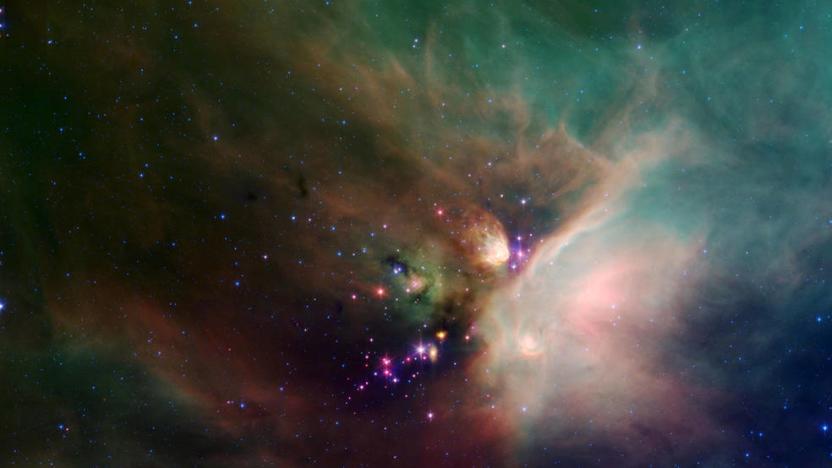spitzer
Latest

NASA decommissions Spitzer Space Telescope after 16 years of service
NASA is flipping the switch on the Spitzer Space Telescope today. The observatory has made groundbreaking discoveries about the universe since its launch in 2003, from imaging some of the oldest stars in the universe to detecting the light reflected by exoplanets. The Spitzer was previously scheduled to go offline in 2018, but has continued operating due to NASA's followup telescope being postponed. With the James Webb Space Telescope nearing completion, Spitzer's mission is over.

NASA extends the Spitzer mission for two-and-a-half years
When the Spitzer telescope blasted off to space on August 25th, 2003, NASA didn't think it would still be doing science by 2016. But since it's alive and well 13 years later, the agency has granted it a two-and-a-half-year mission extension to make discoveries the astronomers "never imagined exploring with the spacecraft." The space telescope's next stage officially called the "Beyond phase" will begin on October 1st this year. It represents a period in the elderly spacecraft's life fraught with engineering challenges due to its age.

Exoplanet census suggests Earth really is special
There are an estimated 700 million trillion terrestrial planets in the observable universe. Among them, Earth may very well be one of a kind according to a new study from Uppsala University in Sweden. Astronomer Erik Zackrisson and his team have been running computer simulations to model all of the terrestrial planets that are likely to exist in the universe. The probabilistic exoplanetary statistics that they've gleaned from these simulations could potentially upend the Copernican principle and will soon be published in The Astrophysical Journal (it's currently up on arXiv).

Astronomers spot a star with a Jupiter-like storm
Unfathomably large storms aren't reserved solely for gas giants like Jupiter... they can exist on stars, too. Astronomers using the Kepler and Spitzer space telescopes have discovered a giant storm on W1906+40, a brown dwarf cool enough ("just" 3,500F) to have clouds full of minerals. It's so large that you could fit thee Earths within its volume, and it's been raging for years. In fact, it wasn't until scientists used Spitzer's infrared detection that they even realized that it wasn't just a massive sunspot.

Hubble spots faint galaxy with 'natural magnifying glass'
NASA's Hubble and Spitzer have been ridiculously successful at spotting distant objects, but some galaxies are too faint to spot directly. Thanks to gravitational lensing, the space telescopes have found the dimmest object ever from the early universe -- a galaxy that existed 13.4 billion years ago, or a mere 400 million years after the big bang. Dubbed "Tayna," or new-born, the object belongs to a new class of faint, newly formed galaxies that have evaded detection until now. It's roughly the size of the Magellanic Cloud near our own Milky Way galaxy, but makes new stars at around ten times the rate.

NASA space telescope discovers Earth's closest rocky neighbor
NASA researchers working with the Spitzer Space Telescope announced on Thursday that they had indeed found the closest rocky exoplanet to our own. It's a tiny burg called HD 219134b that's just 21 light years from Earth in the Cassiopeia constellation, near the North Star. It was first spotted with the 3.6-meter Galileo National Telescope in the Canary Islands before being confirmed with the Spitzer. Even though the planet is larger than Earth, researchers only noticed it as it transited across the face of its parent star (astronomers look for the star to dim then brighten again as evidence of an orbiting planet). Unfortunately, there's basically zero chance that we'll find aliens there as 134b orbits far too close to sustain life.

Earth's orbiting observatories and their literally awesome images
While the Voyager 1 probe, launched in 1977, cruises into interstellar space (the farthest man-made object from Earth) and missions like New Horizons capture snaps from the outskirts of the solar system, we've been keeping the heavy hitters close to home. Massive space telescopes that scan the cosmos with augmented eyes have been orbiting the Earth for years to get a clear view of the universe without atmospheric distortion. The Hubble Space Telescope's 1990 launch set a new precedent for these space-based observatories in terms of scale and abilities. These new instruments have helped scientists gather an incredible amount of data and mind-bending photos from deep space. With Pluto hogging the spotlight lately, we decided to take a look back at some of these powerful orbiting eyes and their visual achievements. [Image credit: JPL]

NASA uses three space telescopes to detect water vapor on Neptune-sized exoplanet
NASA has been discovering one exoplanet after another these days, but its scientists have to look a lot closer if they want to see more details, such as the planets' color or whether they have water. That's exactly what the agency did while observing HAT-P-11b -- by combining the power of three space telescopes, scientists have found clear skies and water vapor on the atmosphere of the Neptune-sized exoplanet. NASA observed the distant world while it was crossing its solar system's sun using one of Hubble's wide field cameras. Water vapor typically absorbs starlight during that process, and it's that light that reaches our telescopes. In order to confirm whether it's actually water vapor (mixed with hydrogen gas and other molecules), the scientists compared Hubble's data to visible-light data collected by Kepler and Spitzer light data taken at infrared wavelengths.

Astronomers theorize what it's like when worlds (and black holes) collide
Tight binary solar systems are inhabited in science fiction -- remember the Star Wars world of Tatooine -- but humanity might find such planets inhospitable over the long term, and not just because of the heat. Using NASA's Spitzer telescope, scientists discovered clouds of dust around three such binary systems far too recent to come from the stars themselves, and theorize that as the stars attract one another over time and get closer and closer together, their respective orbiting planets may get closer as well, and crash into one another catastrophically. Meanwhile, when supermassive black holes dance in pairs, they can merge as one, and astrophysicists have recently simulated how such a joining might appear on our telescopes. According to a team of US and Canadian researchers, the pair may emit strong jets of electromagnetic radiation before they merge, which twist around one another and throw off gravitational waves that can help pinpoint the source. Speaking of sources, we've got plenty of those immediately below if you'd like to read more.

Spitzer wins GamePolitics' biggest political hypocrite poll
GamePolitics had a pretty sweet idea this week when it polled readers on who they thought the biggest political hypocrite is when it comes to the games industry. Was it Boston's Mayor Menino, who's seeking to pass a "games as porn" bill while trying to woo developers to the city; or perhaps California's Gov. Arnold Schwarzenegger who... well, look at the man's career! Nope, the winner, by a wide margin, was New York's disgraced former governor Eliot Spitzer.Spitzer wins the poll for actions like attacking Grand Theft Auto and making sensationalist statements like, "Children can even simulate having sex with a prostitute." Meanwhile, the governor was doing more than simulating when he played the role of Client 9 to a high-priced prostitution service. It's still as delicious to write now as it was a month ago.

GTA critic NY Gov. Spitzer resigns over prostitution connection
Just in case mainstream media isn't your thing, New York governor Eliot "Client 9" Spitzer resigned yesterday over his use of a high-priced prostitution service. FBI wiretaps detailed Client 9 haggling over payment and arrangements, not to mention his kinks -- but this is a family site. Spitzer's been on the video game media radar a few times for taking the moral high ground with false or misleading information. GamePolitics has the money quote from Client 9's 2006 election campaign, where he exclaimed, "Media content has gotten more graphic, more violent and more sex-based ... Children can even simulate having sex with a prostitute." Children may simulate it, but the ex-governor actually did it! Maybe now he'll start playing GTA to recapture the feeling.

NY gov. Spitzer cites hoax site in anti-games campaign
New York Governor Eliot Spitzer recently presented a slide show in his ongoing campaign against video games which contained a heavy dose of sensationalism and just a dash of inaccuracy. Created by the New York Department of Criminal Justice, the 20-minute presentation called "Video Games and Children: Virtual Playground vs. Danger Zone" appears to be an ultimately flawed piece meant to warn parents about violent video games. Originally reported by the Staten Island Advance, GamePolitics breaks down the slide show piece by piece. GP says that the non-commercial V-Tech Rampage -- actually created by an Australian -- gets prominent mention; the presentation also includes a sensationalist clip from Australian television of a teenage World of Warcraft addict. Neither example serve to assist parents in making game purchasing decisions for children based on ratings. There are many more issues with the presentation, but it culminates with a resource page listing Mothers Against Videogame Addiction and Violence -- only problem is that MAVAV is a hoax site created by a student from a New York City school. So take heart, governor, video games can't be all bad. They're at least making kids smart enough to fool politicians.[Via GamePolitics]

NY Governor Spitzer spitting mad about games
"It is now pretty well established that certain types of videos and images have an effect on behavior," New York Governor Eliot Spitzer told reporters yesterday. Spitzer wants video games that are "degrading" to minors regulated the same way as cigarettes for those under 18. Retailers who would sell or rent these "not appropriate" games to minors would face fines.The Democratic governor plans to give details about his plans this Friday in a Manhattan speech before Rev. Al Sharpton's National Action Network. Like wagering how many times President Bush will bring up 9/11 in a speech, start placing your bets now on how long it'll take Spitzer to bring up the VT massacre in his speech.Spitzer's proposal is sure to be in good company with other New York-based bills looking to regulate games. Spitzer better watch his back, the courts have not been kind to taxpayers for overzealous politicians who ignore Constitutional Law 101.






